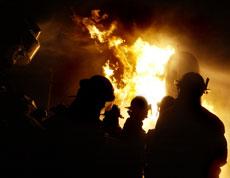Candidates battle fire, gain courage
Nov 19, 2004
Greg Elliot lit a flare and tossed it into a six-story concrete building.
“If you have any exposed skin, it will burn – so cover it up.” said Elliot in a voice muffled by his firefighter mask. “Ready to go up?”
I gripped my camera tighter, hoping that it would survive the night. I entered the burn tower and ascended a staircase with a ceiling of thick, dark smoke above me, heat approaching as I slowly walked up the steps with camera in hand.
On reaching the second floor, I saw two separate fires burning wooden pallets and straw. A window opened and a line of firefighter candidates fell into the tower from the window, a few feet from the fire. The intense heat came closer as I maneuvered to take my pictures.
But as intense as it was for me, the candidates of the University of Illinois Fire Service Institute’s Fall Fire Academy saw much worse as they worked their way toward becoming certified professional firefighters.
Get The Daily Illini in your inbox!
Candidates are brought into a live fire burn on the first day of the academy to help get them adjusted to the conditions of a fire.
“I didn’t expect us to be in burns quite as fast,” said Dana Jennings of the Ottawa Fire Department.
Once in the fire, the candidates changed their story.
“It’s kinda like a sick obsession – it’s cool,” Jennings said. “It was awesome to be in the fires, that close to the fire.”
Each candidates was required to carry a bright orange water bottle at all times – a reminder to stay hydrated.
“For every 20 minutes that firefighters are in (a burning building), they will lose about two liters of fluid,” said Brian Brauer, program director for fire fighting at the IFSI. “Firefighters’ core temperatures have been recorded as high as 106 degrees Fahrenheit, and this type of core temperature elevation is significant enough to affect the cardiovascular system.”
Alpha consisted of seven candidates from around Illinois. Instead of a name, each was called by his or her shift and number.
“We do this,” said instructor Brad Bone, “to remind them that they are candidates and they will have to earn their name.” ÿ
Although Alpha struggled to work as a team in the beginning, “by the first night drill… Alpha really started to come together,” said Justin Twaddle of the Quincy F.D. “And our last night drill in the ‘taxpayer’ (a two-story burn building) is when you could really see it.”
Each working shift is critiqued – both privately and in front of their peers – after each live five drill.
“For the later drills, we critique on two things: We look if they are at the minimum passing standards and if they are at the level they need to be at to move on in the program,” Brauer said.
After graduation, the candidates – now full-fledged firefighters – are looking forward to voluntary classes in Auto Extrication and Technical Rescue at the Institute.
Chris Patterson of the Quincy F.D. said, “It’s not just a job, it’s just a way of life.”
Members of Alpha started rotations at their respective firehouses within a few days of graduation.






